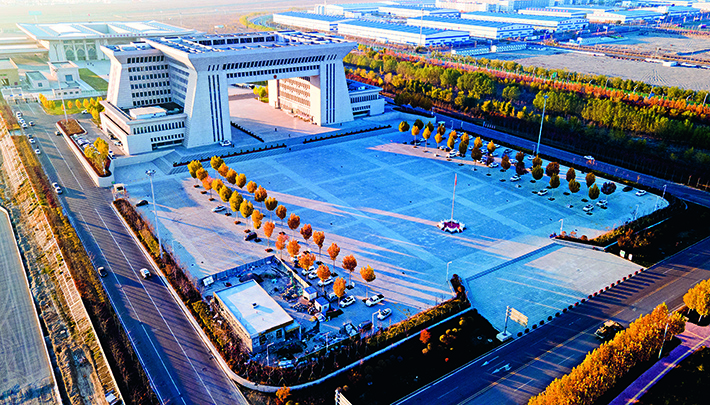|
||||||||||
| Home Nation World Business Opinion Lifestyle ChinAfrica Multimedia Columnists Documents Special Reports |
|
||||||||||
| Home Nation World Business Opinion Lifestyle ChinAfrica Multimedia Columnists Documents Special Reports |
| ChinAfrica |
| A Port of Opening Up |
| Border cities in Xinjiang are playing an important part in China’ cross-border rail transportation |
| By Yang Shuangshuang | VOL. 16 March 2024 ·2024-03-05 |

The border gate at the city of Alashankou
The expedition of Chinese explorer Zhang Qian more than 2,000 years ago is considered to be the foundation of the ancient Silk Road. Today, his legendary exploration of the ancient Silk Road is renowned worldwide. Venturing across the Eurasian continent with camel caravans laden with silk, spices, tea, and other Chinese goods, he forged vital trade routes of the Silk Road. Xinjiang has had a central role in that trade.
Fast forward thousands of years, and Xinjiang finds itself at a new juncture, ready for reform, innovation and growth. The region has experienced continuous expansion in the scope, scale, and breadth of its openness, thanks to the implementation of the Western Region Development Strategy and the Belt and Road Initiative (BRI). The recent opening of the China (Xinjiang) Pilot Free Trade Zone has brought fresh opportunities for the further opening up of Xinjiang.
Sources of strength
Alashankou is situated in a narrow corridor that connects China with West Asia. This region experiences 160 days of windy conditions each year on average.
But the region is not just the recipient of strong cold winds from Siberia; it is also receiving invigorating breeze of development ushered by the BRI cooperation.
A biting cold wind was no barrier to the smooth operation of the Alashankou Railway Port where numerous China-Europe freight trains were being loaded with goods before crossing the border. Under the command of 29-year-old freight officer Bai Zhaoxin, the gantry crane is transferring the goods from one line to another in a smooth manner.
“Before a China-Europe freight train reaches Alashankou Station, it runs on wide gauge in Kazakhstan and other countries, while China uses standard gauge. With an 85-mm-gap between the two types of gauges, train carriages cannot seamlessly traverse the border. Therefore, transshipment is required,” Bai told China Today. He added that although these days are exceptionally busy, he was looking forward to continuous development of the Belt and Road cooperation in this young city of Alashankou.
Guo Hua, deputy director of the cargo loading workshop at Alashankou Station, said that this facility is Asia’s largest indoor transshipment depot, with a total investment of 100 million yuan ($13.9 million). Spanning an area of 19,700 square metres, the transshipment depot features a total track length of 2.64 km and two rows of container yards. With an annual transshipment capacity of 200,000 TEUs, it significantly augments the port’s import and export freight volume.
With a resounding whistle, Guan Xizhi, driver of a China-Europe freight train, drove the train towards Kazakhstan. “Nowadays, we have to make 21-28 trips in a single month, much busier than before,” he said.
Path of opening up
Also known as the “golden port,” Khorgas in Ili Kazak Autonomous Prefecture is a national first-class land port with the longest history in the western region.
Khorgas, literally meaning “a place where camel caravans pass,” used to be an important trading post along the ancient Silk Road. Today, it is a pivotal part of the western route of China-Europe (Asia) Railway Express. As an important window of Belt and Road cooperation, Khorgas epitomises the vibrant development of international trade.
“Ensuring smooth operation of the train is my primary responsibility,” stated Geiensi Tuluhan at the Khorgas railway port. He diligently inspects inbound and outbound trains with the loaded cargos and safety maintenance of the railways. The 35-year-old Kazakh man started to work at the Police Station of the Khorgas Railway Station in 2019, where he has ensured the safe operation of more than 30,000 China-Europe freight trains.
Since the initiation of the Belt and Road Initiative in 2013, the annual number of China-Europe freight trains has hit new highs. Yu Rong, deputy director of the Production Safety Command Centre of the Khorgas Railway Port, said that since the launch of the first China-Europe freight train in 2016, the reach of the freight trains passing through the Khorgas Railway Port has expanded significantly. Initially spanning three cities in two countries, it now extends to 45 cities in 18 countries. Khorgas has emerged as the “golden channel” for land transportation of goods.
“Settling in Khorgas saved the company one-third of freight costs,” said Gu Haifeng, who is in vehicle export business in the city. Attracted by the construction of the core area of the Silk Road Economic Belt, Gu moved to Khorgas from east China’s Zhejiang Province and established Khorgas Asia-Europe International Supply Chain Co. Ltd. in April 2023. The company specialises in the collective customs declaration and clearance of new energy vehicles and automobiles and the direct delivery to the designated supervision warehouse at the destination.
Xinjiang’s foreign trade in goods surged by 47.4 percent year on year in the first 11 months of 2023 to 320.53 billion yuan ($44.55 billion), ranking second in China in terms of growth rate. It marks the first time that Xinjiang’s total foreign trade value has exceeded the 300-billion-yuan ($41.7 billion) mark, setting a new record.

Tourists take photo at the ChinaKazakhstan boarder in Khorgas
Youngest free trade zone
The China (Xinjiang) Pilot Free Trade Zone was officially inaugurated on 1 November 2023, becoming the first such zone in China’s northwest border region and the 22nd pilot free trade zone in the country.
On the occasion of the 10th anniversary of the establishment of China’s first pilot free trade zone, the Chinese government announced the establishment of the China (Xinjiang) Pilot Free Trade Zone. This is an important step towards high-quality development in Xinjiang and marks a new historical starting point for China to deepen its opening up.
On 3 November 2023, another piece of good news added to the positive atmosphere. On this date, Bank CenterCredit, a Kazakh commercial bank, officially established a branch for international traders at the China-Kazakhstan Khorgas International Border Cooperation Centre. The bank is the first foreign lender to settle in the region since the establishment of the free trade zone.
The China-Kazakhstan Khorgas International Border Cooperation Centre where this bank is located is the first cross-border economic and trade cooperation zone established between China and a foreign country.
“Nationals of China and Kazakhstan as well as third countries are granted visa-free access to both countries for up to 30 days with valid documents such as passports. Visitors can partake in special cross-border tourism activities at this centre. Each person is permitted to carry 8,000-yuan ($1,111.9) worth of duty-free goods into China from the centre in a single day,” explained Jiayidaer Alimasi, deputy director of the management office of the China-Kazakhstan Khorgas International Border Cooperation Centre.
| About Us | Contact Us | Advertise with Us | Subscribe |
| Copyright Beijing Review All rights reserved 京ICP备08005356号-5 京公网安备110102005860号 |